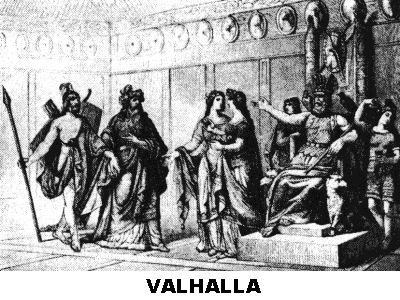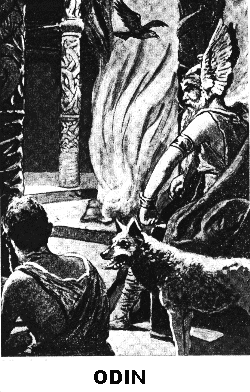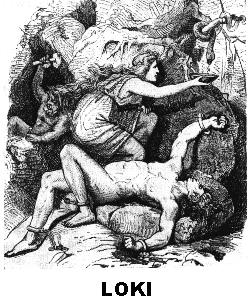THOR Tarp and Norse Mythology
Before we launch into a description of Norse (Teutonic) Mythology let's answer some of the most asked questions about our company and why it's named as it is...
Why "ODIN International, Inc."?
ODIN (O din) was the father of all the gods of Norse Mythology, and he represented wisdom & victory...as such he makes a good figurehead for our corporate entity as he has given birth to many diverse divisions that market products and services worldwide. We all want to make wise choices and we all want to win...at ODIN International, these are our commitments to you, the wisest of choices assuring the greatest possible chances of ultimate success.
Why "THOR TARP Division"?
THOR (thawr) was the eldest son of ODIN and the strongest of all the gods. THOR was the protector of mankind and with his magic hammer, Mjolnir, he fought the battles of the good gods and mankind against the evil giants. The products in our THOR TARP line are the strongest available anywhere, and their purpose is to protect the things of mankind against the ravages of nature. The evil giants in our business are things like rain and rust, snow, wind and ice, damaging UV rays and other pollutants; contamination, leaks & spills are among the things we guard against. When you insist on a Genuine THOR TARP, you get the best protection money can buy...if it doesn't say THOR, it's not a tarp; it's an accident waiting to happen.
Why "ASGARD Web Services"?
Asgard (AHS gahrd) was the home of the good gods, the Aesir (AY sur), and was a wonderful place full of feasting and beautiful palaces. It was where the warriors who fought valiantly were carried by the valkyrie (val KIR ih) battle maidens to feast on wild boar, drink copious amounts of mead and be revived for future battles. Every morning they marched out at the crowing of the cock, and fought furiously; but by midday all wounds healed, and once again the warriors would assemble to feast. The websites we create and host certainly are some of the finest out there. As such, we saw it fitting to give them a place to live fit for the gods.
Why "Valhalla Consulting"?
 ODIN's palace in Asgard was known as Valhalla (val HAL ah). It stood in Gladsheim, the home of joy. It was the greatest , grandest, brightest and largest of the halls there. Valhalla had walls of gold and a roof ornamented with golden battle shields. Huge spears wainscoted the rooms and held up its ceiling. They were so highly polished that a gleam from them was the only light needed in the hall. Coats of mail and other armor hung on the walls. In front of it stood the grove of Glasir, the trees of which bore golden leaves. The 540 doors of the palace were so wide that 800 men could enter side by side. It was from his throne here that ODIN dispatched his two ravens, Huginn (Thought) and Muninn (Memory), to fly around the world each day to bring him the news of all they saw and heard. It was also from here that ODIN gave counsel to the heroes of the time to guide them to further victories.
ODIN's palace in Asgard was known as Valhalla (val HAL ah). It stood in Gladsheim, the home of joy. It was the greatest , grandest, brightest and largest of the halls there. Valhalla had walls of gold and a roof ornamented with golden battle shields. Huge spears wainscoted the rooms and held up its ceiling. They were so highly polished that a gleam from them was the only light needed in the hall. Coats of mail and other armor hung on the walls. In front of it stood the grove of Glasir, the trees of which bore golden leaves. The 540 doors of the palace were so wide that 800 men could enter side by side. It was from his throne here that ODIN dispatched his two ravens, Huginn (Thought) and Muninn (Memory), to fly around the world each day to bring him the news of all they saw and heard. It was also from here that ODIN gave counsel to the heroes of the time to guide them to further victories.
Marketing intelligence and a solid game plan for victory are essential to today's competitive arenas. Businesses must equip themselves with the best advice they can find to avoid the pitfalls that often lead to lost market share, substandard performance levels and diminishing margins. Business is a battle of sorts and an effective plan is the difference between loss and victory.
Now let's explore Norse Mythology and some of the legends that it fosters to this day....."Mommy and Daddy, where do thunder and lightning come from?"
If you've ever been asked this question chances are you will answer in one of two ways. For those more analytical among us, one might launch into an explanation of cloud formations, airborne moisture and wind currents caused by high and low pressure centers running into each other and the interaction of those polarities in creating voltage. It's about this time that the eyes of the child glaze over and as the next bolt descends and the thunder peals the fear and fascination that spurred the question return.
Then of course there are those that take the more simplified and ethereal approach: "Honey, it's just the angels bowling. There's nothing to be afraid of."
If instead you tried what the moms and dads of the Migration and Viking eras used to explain this phenomenon, you might actually make the child feel good about thunder and lightning and look forward to the next thunderstorm. According to Norse Mythology, THOR rode through the heavens on a golden chariot pulled by two large enchanted goats who had sparks flashing from their hoofs and teeth and thunder rumbling from the wheels of the chariot they pulled as they pursued the evil giants through the skies that were attempting to escape them. THOR, the god of thunder, benefactor of man, and the implacable foe of the giants, wearing his magic strength giving belt and magic iron gloves that protected his hands from the red hot hammer, Mjolnir, created thunder and lightning every time he felled another of the evil giants trying to do bad things to little kids and grown-ups.
Why is it called Wednesday, and why is it spelled that way?
Norse Mythology gets credit for naming six out of our seven days of the week, and renaming the seventh! Not many know the origins of these names we all use so frequently. In Wednesday's case, for example, this is the day of the week named after......drum roll please.....you guessed it!.....ODIN.
Wednesday is the English name for the fourth day of the week. The name comes from "Woden" for Woden's day or "ODIN", the chief god in Norse Mythology, to whom it was considered sacred. (Woden is Old English and Wodin is Germanic for Odin; also Odhinn, Wodan, & Wuotan). So when they modernized the word, they changed the "o" to an "e", switched the "e" with the "n" and left out the apostrophe...and just that simply Woden's day became Wednesday.
But let's start at the beginning. Sunday..."was the day sacred to the sun among old Teutonic peoples, and its name means day of the sun".
The next one is just as easy...Monday..."the word comes from the Anglo-Saxon monandaeg, which means the moon's day. In ancient (Teutonic) times each of the seven days was dedicated to a god or goddess. Monday was sacred to the goddess of the moon." Tuesday, the name of the third day of the week, was taken from Tiu, or Tiw, which was the Anglo-Saxon form of Tyr, the name of the Norse god of war. Tyr was the son of Odin, or Woden.
So if Tuesday was named after one son of Odin, and Wednesday was named after Odin himself, can you guess who Thursday was named after? Right, THOR...Thursday, as the fifth day of the week was named after Odin's eldest son, THOR, means Thor's day, and was considered by ancient Norsemen to be sacred to the Teutonic god of thunder and agriculture, son of Odin & Jord (mother earth) and champion of the Aesir.
So what about Friday, was there a Fri?
Pretty close...meet Freyja (FRAY ha), the goddess of love and beauty in Norse mythology. She was the sister of Frey (fray) (who had the power over rain and sunshine, and at who's command the fruits of the earth grew and prosperity followed), and daughter of the great sea god, Njord (the head god of the Vanir). Freyja was like Venus in Roman mythology, but she is sometimes a war goddess (now let's see....love, beauty and war; yep, sounds like somebody I know!). Often she went with the Valkyries to the battlefield. After a fight she claimed half of the dead men, and let the spirit of life (Odin) have the other half. She took them to her palace. There she revived them and held a feast for them. Freyja eventually married a god named Oder, but he didn't know what he had, and deserted her to travel and seek other women. Freyja could not stop weeping, and her tears were drops of gold. In Norse poetry, gold is called the tears of Freyja, or the rain of Freyja's cheeks. The cats which drew her chariot are symbols of her enjoyment of the senses. Her many names show the different ideas about love in life. So Friday comes from the Anglo-Saxon word Frigedaeg, which means Freyja's day.
Those are the six out of seven named from Norse mythology, and the seventh day, Saturday, "called Saeter-daeg by the Anglo-Saxons is named for the Roman god Saturn. It is the only day named for a Roman god." So score that six for the Norsemen and one for the Romans!
What are these Valkyries you keep mentioning?
These were the warlike goddess-maidens of Norse Mythology who attended Odin. Yes, even the women fought in these ancient Viking battles. They rode on swift horses, sang war cries, were armed with spears, shields, helmets and brilliant armor, and rode through the air distributing Odin's commands. Odin also dispatched them to every battlefield to choose the bravest of the dead heroes and bring them back to Valhalla. (I wonder if Odin knew the Valkyries were in cahoots with Freyja to give her first pick?) Life giving dew fell from the manes of their horses, light streamed from the points of their spears, and a flickering brightness heralded their arrival on the scene of the battle. They carried the dead on their horses and lead their souls across the bridge Bifrost, which was the only path from Midgard (the rainbow) to Asgard (heaven), into the hall of Valhalla. Then they put on white robes acting as cupbearers to the immortalized warriors and served them a daily feast of wild boar and horns of mead (a fermented drink made from honey). Sometimes in Norse poetry, they are described as supernatural beings of giant stature, striding across the mountains or appearing in time of danger to take up the hero and carry him out of his predicament.
The Valkyries were represented as being of diverse origin; some were descended from elves and other supernatural creatures, while others were the daughters of noble men.
They are also said by Saxo to vary their appearance, and to be seen sometimes as fearsome beings and sometimes as beautiful maidens, who offer love to the warrior (sounding familiar?). Protective spirits of this kind were said to attach themselves to the kings and princes who worshipped Odin, giving them help and counsel and bringing them luck in battle, while at their death they received them as their husbands.
"What else can you tell us about Odin?"
How about this 2-part $64,000 question...What was the name of Odin's horse and how many legs did he have? OK, give up? "In the Viking Age, Odin was pictured traveling through the skies on Sleipnir, his mighty eight legged horse who could carry his spirit to worlds beyond the earth."
 The story of the birth of this horse of Odin is found in the story of the building of the wall round Asgard, the stronghold of the gods. A giant offered to build a wall for them in the space of one winter. It was agreed that, if he could finish the work on time he should have the goddess Freyja and the sun and the moon as payment. The gods thought themselves quite safe in making such a bargain, but the giant brought with him a marvelous horse called Svadilfari, which was so intelligent and swift that when the beginning of spring was only three days away, the wall was practically complete. The gods, however, were saved from making payment by the cunning of Loki, the trickster of Asgard, who took on the form of a mare, and neighed at the stallion until he was lured away from his work. Thus the wall was never finished, and THOR slew the giant with his hammer, and Loki in the guise of the mare gave birth to an eight legged colt. This was Sleipnir, the finest of all steeds, whom Odin kept for himself."
The story of the birth of this horse of Odin is found in the story of the building of the wall round Asgard, the stronghold of the gods. A giant offered to build a wall for them in the space of one winter. It was agreed that, if he could finish the work on time he should have the goddess Freyja and the sun and the moon as payment. The gods thought themselves quite safe in making such a bargain, but the giant brought with him a marvelous horse called Svadilfari, which was so intelligent and swift that when the beginning of spring was only three days away, the wall was practically complete. The gods, however, were saved from making payment by the cunning of Loki, the trickster of Asgard, who took on the form of a mare, and neighed at the stallion until he was lured away from his work. Thus the wall was never finished, and THOR slew the giant with his hammer, and Loki in the guise of the mare gave birth to an eight legged colt. This was Sleipnir, the finest of all steeds, whom Odin kept for himself."
Odin was the chief god of Northern mythology and from his throne seat Valaskjalf, he ruled the heavens and earth omnisciently. By drinking from Mimir's fountain he became the wisest of gods and men, but he purchased the distinction at the cost of one eye. Frigga was his queen but he had other wives and favorites and numerous sons and daughters. To him answered all of the Aesir, the gods of the Teutonic pantheon collectively.
Do you remember the "Sword in the Stone" story? Well, before that story was the real version... "The Sword in the Tree." To those that dedicated their efforts to Odin, he gave great gifts. In one such case he gave a splendid sword to Sigmund the Volsung, then Odin himself plunged the sword deep into the tree forming the central pillar of the family hall, so that only the hand of this young hero, an einherjar (soldier of Odin), who had won his favor was able to withdraw it.
What was Odin's favorite weapon?
Odin's great treasure was his mighty spear Gungnir, which could determine victory by the direction which it took over the battlefield. Well into the middle ages it was still thought a lucky omen to throw a spear over the heads of an advancing band of enemies. The horned helmets that are so familiarly associated with the Vikings and their expeditions and attire were said to bear horns ending in eagle's beaks, the mark of Odin.
Why did Odin wear so many rings?
Another of the treasures of Odin was the self-perpetuating gold ring Draupnir, from which nine new gold rings dropped every ninth night. As a leader in battle, Odin was naturally viewed as a ring-giver, dealing out treasure in the form of gold rings to his followers. There may also be a symbolic link with the three intertwined triangles or rings, known as the valknut, which can be seen on the carvings of the Gotland Stones of the Viking Age and elsewhere in association with Odin much like the linked rings of the Olympics.
What was Odin's greatest gift to the gods and men?
Before we answer that, we must study some of Odin's other magic capabilities. Odin could turn himself into an eagle and fly through the heavens. The eagle which sat on the world tree as pictured on many of the Gotland stones of antiquity may well have been Odin himself, since he had a special seat from which he could view all the worlds at once. Odin could also lie as if asleep, while his spirit could journey in the twinkling of an eye to far-off lands in the form of a bird or wild beast, fish or dragon. Odin flew in the form of an eagle when he won the greatest gift, the mead of inspiration. The mead was prepared from the blood of the wise giant Kvasir, who was created by the gods. He was killed by the dwarfs, who mixed his blood with honey and brewed the marvelous drink. It could give to him who drank it the power to compose poetry, or to speak words of wisdom. An intoxicating drink was probably an essential part of the rituals of worshipping Odin. Is there a moral to this story? If you're going to drink and utter profound sayings, you should probably do it on Wednesdays.
Are there any of these gods we should especially watch out for?
Yes, keep your eyes peeled for a rascal named Loki. He was an enigmatic, mischievous, sometimes demonic, schizophrenic figure who appears occasionally as a helper but mostly as an enemy of the gods stirring up all kinds of trouble that others must contend with. Sometimes he is more closely associated with the giants, (Jotunn) than the gods of which he is one.
 Loki was credited with the killing of Balder, the favorite son of Odin's wife Frigga. Balder was so beloved of his mother, that Frigga endowed him with the power of being impervious to wounds by taking a pledge from all plants, trees and metals that weapons made of them would cause him no harm. She neglected one small plant, however, which grows not on the ground but on an oak tree, the mistletoe. From this plant, Loki made a dart and gave it to Balder's brother Hoder suggesting he hurl it at Balder in sport. When Hoder threw the dart, however, it pierced Balder like a spear and he fell dead. For this Loki was chained to a rock with a snake hung over his head. The poison of the snake dripped into his face and made him howl with pain and agony. According to one legend, Loki will remain chained until the gods no longer rule. Then he will break his bonds and the earth will be drowned under the sea.
Loki was credited with the killing of Balder, the favorite son of Odin's wife Frigga. Balder was so beloved of his mother, that Frigga endowed him with the power of being impervious to wounds by taking a pledge from all plants, trees and metals that weapons made of them would cause him no harm. She neglected one small plant, however, which grows not on the ground but on an oak tree, the mistletoe. From this plant, Loki made a dart and gave it to Balder's brother Hoder suggesting he hurl it at Balder in sport. When Hoder threw the dart, however, it pierced Balder like a spear and he fell dead. For this Loki was chained to a rock with a snake hung over his head. The poison of the snake dripped into his face and made him howl with pain and agony. According to one legend, Loki will remain chained until the gods no longer rule. Then he will break his bonds and the earth will be drowned under the sea.
Another story of Loki's mischievous conduct involves Sif, the wife of Thor. She had long golden hair which covered her from head to foot like a veil. Thor was very proud of his wife's hair, but she awoke one morning and found it all gone. Thor was angry and said that he would punish the thief. He believed that Loki had taken it. At last he captured Loki and made him admit his guilt. Thor was going to punish him, but Loki promised to get new hair for Sif. Loki went to the land of the dwarfs. He begged Dvalin, their chief, to make the hair for him. Loki had also angered Odin and Frey, and he asked for presents for them as well. Dvalin took fine threads of gold and spun long tresses of hair. They grew as soon as they touched the head of Sif.
The dwarfs got so interested in the spinning of the hair that they tried to see which one could make the most clever and magic things. They made for Odin an enormous boar with golden bristles and the magic spear, Gungnir, which would always hit its mark. A wonderful ship that could sail over land and water was made for Frey, as well as a magic ring. But the dwarfs made three very useful gifts for Thor. The first was his magic hammer, Mjolnir, that came back to the hand that threw it. The hammer was always red hot so they made a pair of magic gloves to protect Thor's hands. The third gift was a magic belt which doubled Thor's already impressive strength when he wore it around his waist.
This story is so typical of both the poetry and irony of Norse mythology. From the nasty deed of a trouble making god came many good things that went on to benefit the good gods and through their deeds, the common man. Think about it. Not everything in life is good and wholesome; many things go awry and seem to be insurmountable hurdles. Eventually, though, they seem to work themselves out and from the experience comes knowledge and good.
More information on Norse Mythology...


